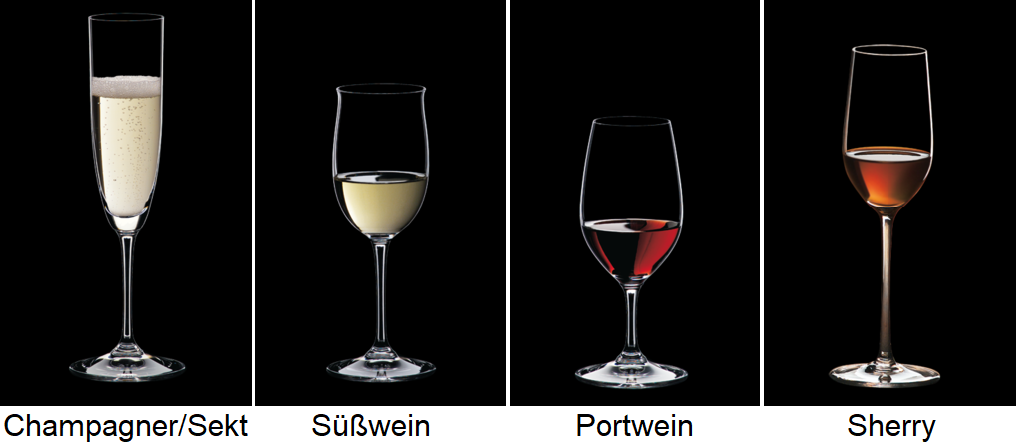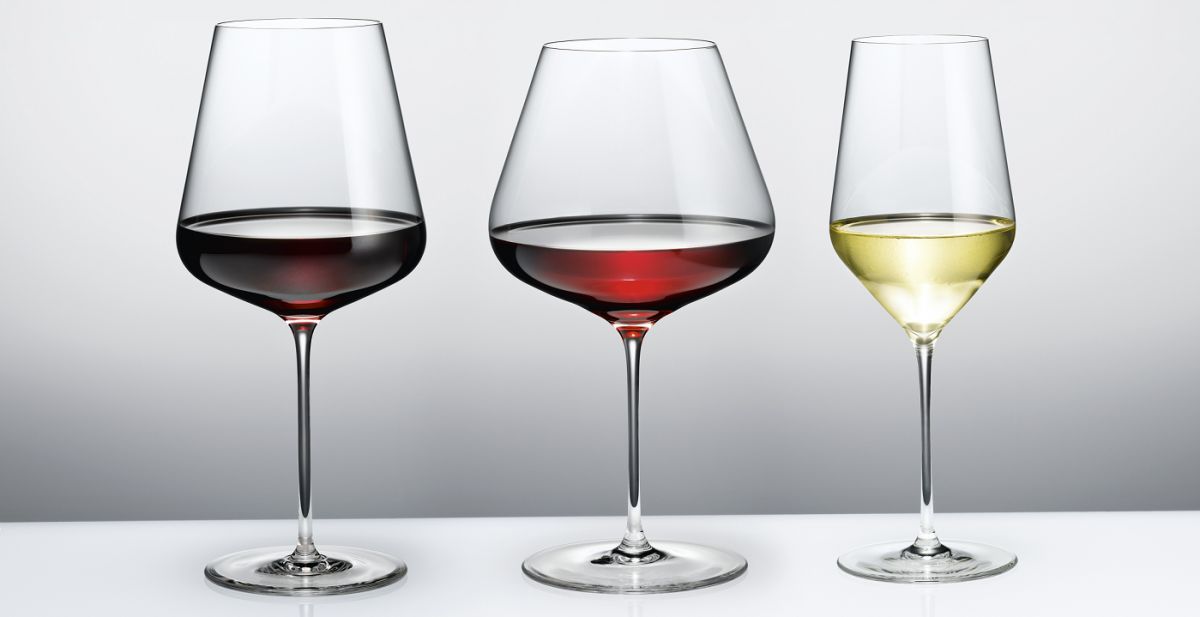Despite their many variations, wine glasses have the same basic structure. They consist of a foot, stem and goblet. The space between the poured wine and the upper rim of the glass is called the chimney. The biggest difference is the shape of the goblet. The more bulbous the goblet, the greater the surface area of the liquid. And the longer or higher the chimney, the greater the volume. The larger the surface and the volume, the more intensively the fragrances can unfold. There are also wine glasses without stems, some with handles. Such glasses are only accepted by purists for drinking water or for simple draught wines. Drinking a Grand Vin from Bordeaux from such a glass would be sacrilegious. But they are very popular, especially in southern countries. In the following, we will assume classic wine glasses.

Choosing the right wine glasses
Choosing the right glasses is almost as important for optimal wine enjoyment as the right wine temperature. The guideline is to use generously proportioned glasses whose goblets taper towards the top in order to retain the aroma and bouquet of the wine in the goblet. This applies to most wines with a few exceptions. For an acidic wine, you can also use a glass whose bowl widens slightly at the top. White wine glasses usually have a relatively small volume so that the wine cannot warm up so quickly. Red wine glasses have a large volume; the large surface area allows the wine to absorb more oxygen and develop its bouquet better. This phenomenon, however, depends above all on the optimal ratio between surface area and volume. Such glasses are also called Bordeaux glasses. There are also specially shaped glasses for different varietal wines, which may seem exaggerated.

There are special glasses for sweet wine or dessert wine with a much smaller volume than other wine glasses. For such drinks, quantities of no more than 0.1 litre are usually poured (i.e. not even an eighth of a litre). The goblet is much slimmer than in glasses for dry wines. But here, too, the goblet is tapered towards the top in order to direct the sweetness to the tip of the tongue, where the specially developed taste buds are located and the sweetness can best be perceived. To portray the personality of the grape variety and the wine character, the right shape of glass must be chosen. The shape of the glass is therefore responsible for the optimal flow of the wine from the glass into the mouth. This directs the wine specifically to the relevant taste zones of the tongue.

Influencing taste through the shape of the glass
The way the wine hits the tongue (narrow, wide, front or back) is determined by the shape, volume and diameter of the rim of the mouth and its texture (rolled rim, abrasive rim). The individual taste of a wine is best perceived when it hits the area of the tongue that is particularly sensitive to it. For sweet this is the tip of the tongue, for salty the front and for sour the back edge of the tongue (left and right respectively), and for bitter the upper surface of the tongue in the back area (but of course the boundaries are not exactly delineated). The first impression is the most important. All taste sensors are activated, right up to the finish or aftertaste.
The alcohol content, the acids, the residual sugar or all aroma substances are elementary components of every wine (see also total extract). The task of the glass is to present the wine harmoniously. The shape of the goblet determines whether the aroma can concentrate and how the wine is distributed on the tongue and palate. The wine flows in a narrow stream onto the tongue and captures the tip of the tongue first. When tasting, one does not take the mouth too full, distributes the wine throughout the entire oral cavity and allows the taste to linger a little while while swallowing. For professional wine evaluations, special tasting glasses are used, which are also available in black, so that you have to rely entirely on your palate and nose.
Glass cleaning and storage
When cleaning, make sure that no foreign odours get into the glass in the process. Lead crystal glasses are particularly susceptible to this. This can happen relatively easily when using a dishwashing detergent, for example, if residues of the perfume remain in the glass. When cleaning, care should also be taken to ensure that rancid grease residues in the dishcloth do not cause an unpleasant nuisance. Ideally, only hot water should be used for cleaning and fresh paper towels for drying. But even water or mineral water can cause a negative sensory impact if it contains a lot of lime. At professional tastings, cleaning is done by to rinse with wine, i.e. rinsing with the next wine. When storing the wine, it is also important to ensure that odours from the surroundings do not get into the glass. These can be furniture polishes or fresh paint surfaces, which can contain intense fragrances.
new glass shapes
A new development is "breathable glass". If you believe the producers, a wine reaches the full development of its aromas after only two to four minutes, because the reaction of the wine with atmospheric oxygen, which is already taking place, is greatly accelerated by the special glass. This effect is conventionally only possible by decanting for one to two hours. Reinhard Conradt, professor at the Chair of Glass and Ceramic Composites at RWTH Aachen University, thinks there is a scientific explanation. In his opinion, the glass could contain surface-active elements such as zinc, for example, which cause increased oxygen transport along the contact surface between glass and wine. One must not understand the term "breathing glass" literally.

The latest trend is "square" glasses. The goblet has a "bend" compared to conventional glasses with a round-oval shape. Studies have shown that this elicits more precise aromas and flavour components from the wine and particularly emphasises finesse and minerality. However, weaknesses and wine faults also become more apparent. Such glasses are therefore called "analytical". This glass shape is produced by the Zalto company under the brand name "Denk'Art" named after the Austrian "wine priest" Hans Denk. Well-known wine glass brands are Eisch, Leonardo, Lobmeyer, Oneforall, Orrefors, Riedel, Stölzle, Zalto and Zwiesel. As a latest achievement, some producers bottle certain wines in ready-to-drink wine glasses. This form is called ready-to-drink.
further information
The largest collection of wine glasses in the world, with an entry in the Guinness Book of Records, comes from Austria. For more information, see also Bordeaux glass and Burgundy glass (red wine glasses), Caña and Catavino (sherry glasses), champagne glass, cocktail, cognac glass, port wine glass, and a complete list of all drinking vessels under Wine vessels. Regarding "food and drink", see under wine enjoyment and wine with food.
Wine glasses and grapes: by Photo Mix on Pixabay
Carafe: by Pearson Scott Foresman, Public domain, Link
Glasses from Bordeaux to Sherry: Riedel from Serie Vinum
Voices of our members

There is a vast number of sources on the web where one can acquire knowledge about wine. But none has the scope, timeliness and accuracy of the information in the encyclopaedia at wein.plus. I use it regularly and rely on it.
Sigi Hiss
freier Autor und Weinberater (Fine, Vinum u.a.), Bad Krozingen